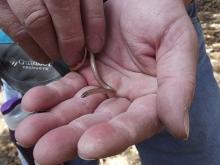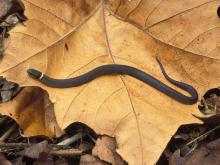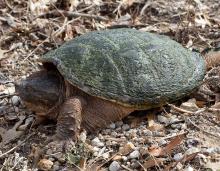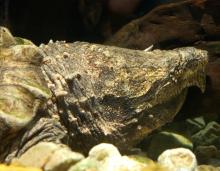Reptiles and Amphibians
Media

Species Types
Scientific Name
Storeria occipitomaculata
Description
The red-bellied snake is one of Missouri's smallest snakes. It is gray or reddish brown on top, usually with narrow stripes, and bright red or orange below. It occurs nearly statewide but appears to be absent from the northwest and southwest corners.
Media

Species Types
Scientific Name
Tantilla gracilis
Description
The flat-headed snake is Missouri's smallest snake. It is found in the southern half of the state except the far southeastern corner.
Media

Species Types
Scientific Name
Haldea striatula (formerly Virginia striatula)
Description
The rough earthsnake is a small, plain-looking snake of open, rocky woodlands in the Missouri Ozarks. It normally doesn’t exceed 10 inches in length.
Media

Species Types
Scientific Name
Diadophis punctatus arnyi
Description
Prairie ring-necked snakes are easily recognizable by their small size, uniform dark color on the back, bright yellow-orange belly, and distinct yellow ring around the neck. Secretive, but common nearly statewide.
Media

Species Types
Scientific Name
Plestiodon fasciatus
Description
The common five-lined skink is one of Missouri's most abundant skinks. Adults are olive or tan with lengthwise stripes. It is often called the blue-tailed skink for the coloration of juveniles. Occurs nearly statewide.
Media

Species Types
Scientific Name
Terrapene ornata
Description
The ornate box turtle usually has four hind toes. Its high-domed shell is usually smooth on top, lacks a ridge, and is brown with yellow lines. Look for it in grassy habitats.
Media

Species Types
Scientific Name
Phrynosoma cornutum
Description
The Texas horned lizard is rare in Missouri but once lived in several southwestern counties. Its name comes from the large, hornlike scales along the back of the head.
Media

Species Types
Scientific Name
Plestiodon laticeps
Description
The broad-headed skink is a large, smooth-scaled lizard that lives in the southern two-thirds of Missouri. It is frequently confused with the common five-lined skink, which is smaller.
Media

Species Types
Scientific Name
Chelydra serpentina
Description
A large aquatic turtle with a big pointed head, long thick tail, and small lower shell, the eastern snapping turtle is common throughout the state, anywhere there is permanent water.
Media

Species Types
Scientific Name
Macrochelys temminckii
Description
In Missouri, alligator snapping turtles are protected, and it is illegal to harvest them. This species is totally aquatic and rarely leaves the water. In Missouri, it mainly occurs in the large rivers, sloughs, and oxbow lakes of our southern, southeastern, and eastern counties.
See Also
About Reptiles and Amphibians in Missouri
Missouri’s herptiles comprise 43 amphibians and 75 reptiles. Amphibians, including salamanders, toads, and frogs, are vertebrate animals that spend at least part of their life cycle in water. They usually have moist skin, lack scales or claws, and are ectothermal (cold-blooded), so they do not produce their own body heat the way birds and mammals do. Reptiles, including turtles, lizards, and snakes, are also vertebrates, and most are ectothermal, but unlike amphibians, reptiles have dry skin with scales, the ones with legs have claws, and they do not have to live part of their lives in water.





















